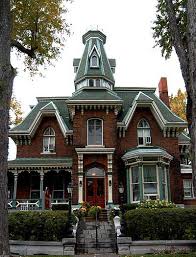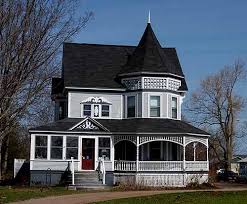

Queen Anne-style homes are a distinctive and highly ornamental type of Victorian architecture that became popular in North America during the late 19th century, particularly from the 1880s through the early 1900s. In Eastern and Central Ontario, Queen Anne homes can be found in both urban and rural settings, often in neighborhoods developed during this period. The style is characterized by its asymmetry, intricate detailing, and use of varied materials, making it one of the most visually striking and charming home styles of the Victorian era. These homes exude a sense of grandeur and individuality, with each one often featuring unique design elements and a whimsical quality.
Key Features of Queen Anne-Style Homes in Eastern and Central Ontario:
- Asymmetrical Facade: One of the most defining characteristics of Queen Anne homes is their asymmetrical design. These homes typically have irregular shapes, with varied rooflines, protruding bays, and angled walls. The facades are not symmetrical, which creates a dynamic, almost picturesque look. This departure from the rigid symmetry of earlier architectural styles like Georgian and Colonial makes Queen Anne homes visually interesting and distinct.
- Complex Rooflines: Queen Anne homes are known for their steep, complex rooflines, which often include multiple gables, towers, and dormers. The roofs are typically steeply pitched and can feature a combination of hip and gable designs, sometimes with ornate detailing like finials, turrets, or scalloped shingles. This intricate roof design not only enhances the visual appeal of the home but also provides additional attic space or light for upper-story rooms.
- Wraparound Porches: Many Queen Anne homes in Ontario feature large, wraparound porches that extend across the front and sometimes the sides of the house. These porches, which are often supported by decorative columns, are a hallmark of the style and create an inviting, relaxed outdoor living space. The intricate railing designs and ornamental touches on the porch further highlight the home’s attention to detail and craftsmanship.
- Towers and Turrets: Queen Anne homes frequently include towers or turrets, which add a sense of verticality to the design. These towers are typically circular or polygonal in shape and are placed at one or more corners of the house. Turrets create a fairy-tale or castle-like quality, making Queen Anne homes appear grand and stately, even in more modest sizes. In Ontario, these features can be found in homes built in the late 19th or early 20th century, often in urban areas or older neighborhoods.
- Ornate Woodwork and Detailing: The Queen Anne style places a strong emphasis on decorative woodwork, both on the exterior and inside the home. On the exterior, this can include finely crafted wooden trim, spindles, and decorative brackets under the eaves, as well as patterned wood panels or latticework on the porch. Inside, Queen Anne homes often feature wood paneling, built-in cabinetry, and ornate moldings. These features give the home a sense of craftsmanship and artistic flair, making each house unique.
- Varied Materials and Textures: Queen Anne homes are known for their use of a variety of materials, which helps to create visual interest. The exteriors often combine wood, brick, and stone in different ways. For example, the lower portion of the house may be built from brick or stone, while the upper floors might feature wood siding or shingles. Additionally, decorative elements such as patterned brickwork, wood paneling, and stained glass windows add texture and depth to the home’s exterior. In Ontario, Queen Anne homes often use local materials, such as Ontario limestone, brick, and wood siding, reflecting the region’s natural resources.
- Tall, Narrow Windows: Queen Anne homes typically feature tall, narrow windows, often with multiple panes or in groups of three. These windows can be adorned with decorative elements like shutters or stained glass, which adds color and texture to the facade. On the second floor, windows may be grouped in a bay formation, which helps to expand the interior space and create a light-filled room. The use of large windows makes these homes feel open and airy, particularly on the upper floors.
- Stained Glass Windows: One of the most decorative aspects of Queen Anne-style homes is the use of stained glass windows. These windows often feature intricate patterns or scenes in vibrant colors, adding a sense of elegance and artistry to the home. Stained glass is commonly found in entryways, above doors, or as transom windows. In Ontario, stained glass was frequently used to enhance the grand entrance of a home, giving it an added layer of beauty.
- Bold, Rich Color Schemes: Queen Anne homes in Ontario often feature bold and vibrant color schemes. The homes may be painted in multiple contrasting colors, with the body of the house in one shade and the trim in a contrasting color, highlighting the ornate detailing. Common color combinations include deep greens, reds, browns, and yellows, with the trim often painted in a lighter or complementary color. The use of color helps to emphasize the home’s intricate architectural features, making it stand out in the neighborhood.
- Functional and Formal Interior Layout: Inside, Queen Anne homes typically feature spacious rooms with high ceilings (often 10 feet or more), which gives the home a sense of grandeur. The interior layout is usually centered around a grand central hallway with rooms branching off to the sides. The living room, dining room, and kitchen are often distinct, yet interconnected spaces, reflecting the formal social life of the era. Queen Anne homes also have a strong focus on natural light, with large windows and sometimes skylights to illuminate the interior.
Variations of Queen Anne Homes in Eastern and Central Ontario:
- Urban Queen Anne Homes: In urban centers like Toronto, Ottawa, and Kingston, Queen Anne-style homes are often larger and more ornate, reflecting the prosperity of the era. These homes are frequently found in older neighborhoods that were developed in the late 19th or early 20th century. Urban Queen Anne homes may have more formal designs with highly decorative elements, such as intricate woodwork, decorative chimneys, and grand entryways.
- Suburban and Rural Queen Anne Homes: In suburban or rural areas of Eastern and Central Ontario, Queen Anne homes tend to be slightly more restrained in terms of decoration, but they still retain many of the key elements of the style. These homes may be set on larger lots, with sprawling gardens and wraparound porches. The use of varying materials and textures remains prominent, though the homes may have simpler detailing in less urbanized areas.
- Restored Queen Anne Homes: Many historic Queen Anne homes in Ontario have been carefully restored or renovated to retain their original charm while incorporating modern amenities. These homes may have undergone updates to meet current building codes and energy efficiency standards, but they still maintain their unique design features, such as intricate woodwork, decorative windows, and multi-color exteriors. In some cases, Queen Anne homes in Ontario may be designated as heritage properties, preserving their historical significance.
Queen Anne Homes in Ontario’s Climate:
Queen Anne-style homes in Ontario are particularly suited to the region’s varied climate, including cold winters and humid summers. The steep rooflines help prevent snow accumulation, which is important during Ontario’s long winters. Additionally, the use of brick and stone in the lower portions of the exterior provides durability and insulation, while the high ceilings and large windows allow for proper ventilation and natural light during the warmer months.
Conclusion:
Queen Anne-style homes in Eastern and Central Ontario are among the most distinctive and charming houses from the Victorian era, with their bold, asymmetrical facades, ornate details, and intricate craftsmanship. These homes capture the exuberance and creativity of the late 19th century, making them architectural treasures in both urban and rural areas. Whether found in the heart of a city or nestled in the countryside, Queen Anne homes are timeless examples of architectural beauty, offering a mix of historical grandeur and whimsical charm that continues to captivate homeowners and visitors alike.

